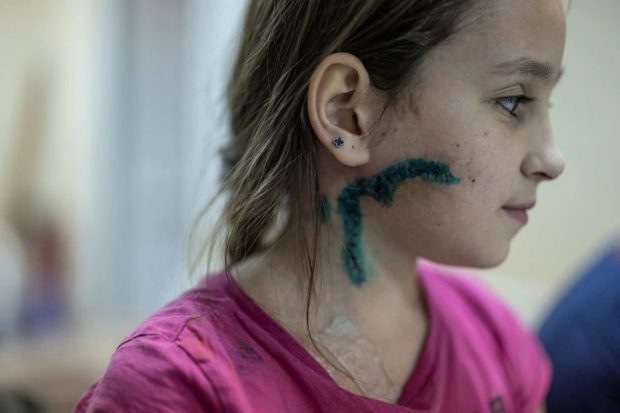
Milana an 11-year-old girl who was wounded during the shelling of Mariupol, sits in a bed in the children’s ward of the hospital, as Russia’s invasion of Ukraine continues, in Zaporizhzhia, Ukraine, March 29, 2022. REUTERS
ZAPORIZHZHIA, Ukraine –Eleven-year-old Milena Uralova remembers being knocked unconscious and waking up to see her mother Yelena weeping after she was wounded while the family was escaping from the besieged Ukrainian city of Mariupol two weeks ago.
Now recovering in the relative safety of a childrens’ hospital in Zaporizhzhia, some 200 km (124 miles) away, she recounts the incident calmly, a bright green line on the side of her face and neck marking the area where doctors have treated her wounds.
“I saw darkness and there was a loud noise ringing in my ears,” she said. “When I opened my eyes, I saw my mother holding me in her arms. She put me on the ground and started crying and asking for help.”
According to Yelena, Milena was wounded when Russian troops opened fire as the family passed through a checkpoint on the way to Zaporizhzhia, an industrial town that has become a key transit point for evacuees fleeing from Mariupol.
Busloads of evacuees arrive in the city before moving further west, joining an exodus where around a quarter of Ukraine’s 44 million people have had to leave their homes to seek refuge either in safer areas of the country or abroad.
Next to Milena, Sasha, an 11-year-old boy, also from Mariupol, sits with a large white bandage on his nose, the legacy of a rocket strike that hit as he was playing with friends. “I was very afraid, there was a lot of blood everywhere,” he said.
Mariupol, a port city on the Sea of Azov, has become a symbol of suffering more than a month after Russia invaded its smaller neighbour in what the Kremlin calls its assault a “special operation” to disarm and “denazify” Ukraine.
According to city authorities in Mariupol, nearly 5,000 people, including about 210 children, have been killed since the Russian assault began.
Russia denies its forces target civilians but local authorities say at least 80% of the city has been destroyed and United Nations agencies have warned of “extremely dire” conditions in Mariupol and other cities.
Evacuees who make it into Zaporizhzhia, usually after an arduous and dangerous journey by car or bus, recount a ruined wasteland of rubble without power or heating, where people cook on open fires and drink rainwater or melted snow.
“Mariupol is gone, it’s bombed out,” said Katia Semeniuk, 77, sitting in a crowded supermarket that has been converted into a reception centre where the evacuees are offered food, warm clothing and assistance.
A noticeboard is covered in handwritten messages with appeals for help finding lost relatives or offers of help with travel. Volunteers help with administration and coordinate personal details of people with lost documents.
Semeniuk arrived in Zaporizhzhia after weeks spent moving from shelter to shelter in Mariupol, where she had taken refuge with her son after being bombed out of her own house in a village outside the town.
“There was a house, we had everything, and now there is nothing left,” she said.
For many of those who have escaped, the future is uncertain as no one can tell how long the fighting will last.
But Milena, a keen gymnast, has some ideas. With their city in ruins, the family is heading for neighbouring Lithuania, far to the west.
“I have a dream that when we get to Lithuania, we will find a gym and I can train again,” she said.
RELATED STORIES
Kremlin says peace talks should continue, lashes ‘hostile’ Ukraine
Serbians go to polls to pick president, parliament amid Ukraine war
Ukrainian president says retreating Russian troops are leaving mines
Ukrainian photographer and Reuters contributor, Maksim Levin, killed covering war